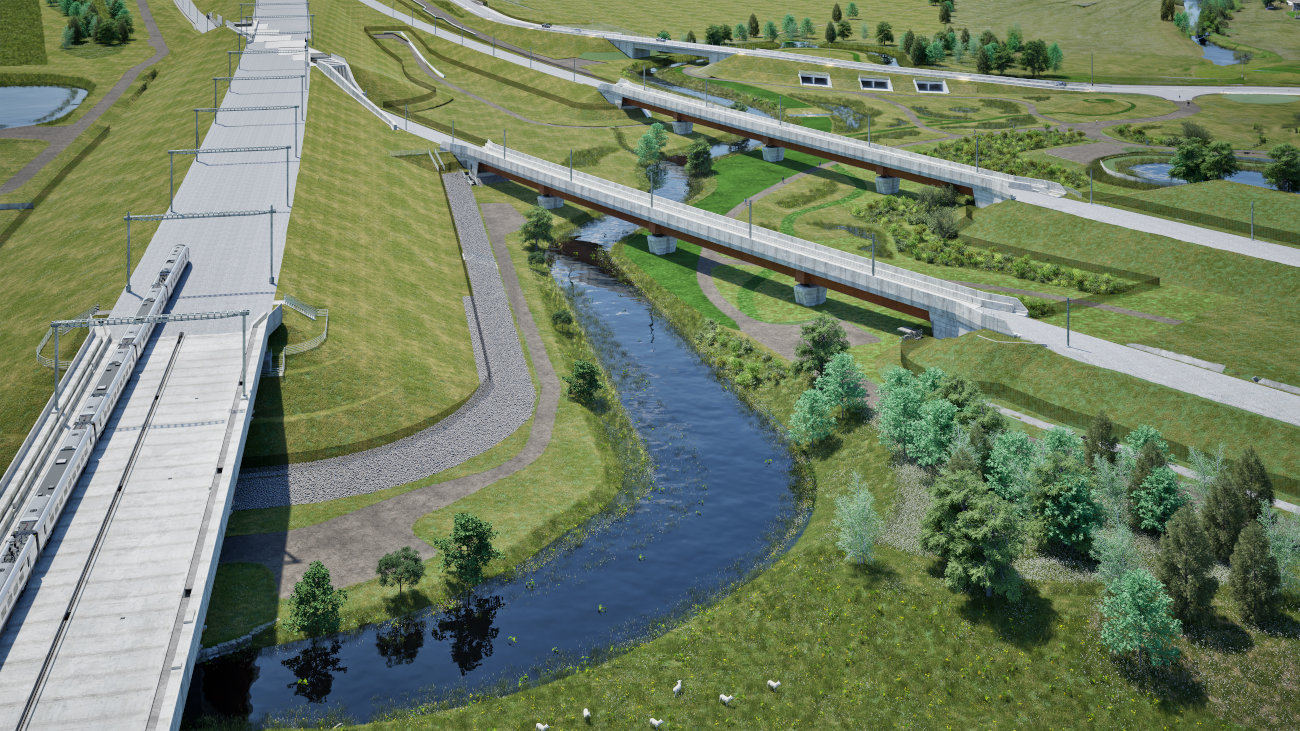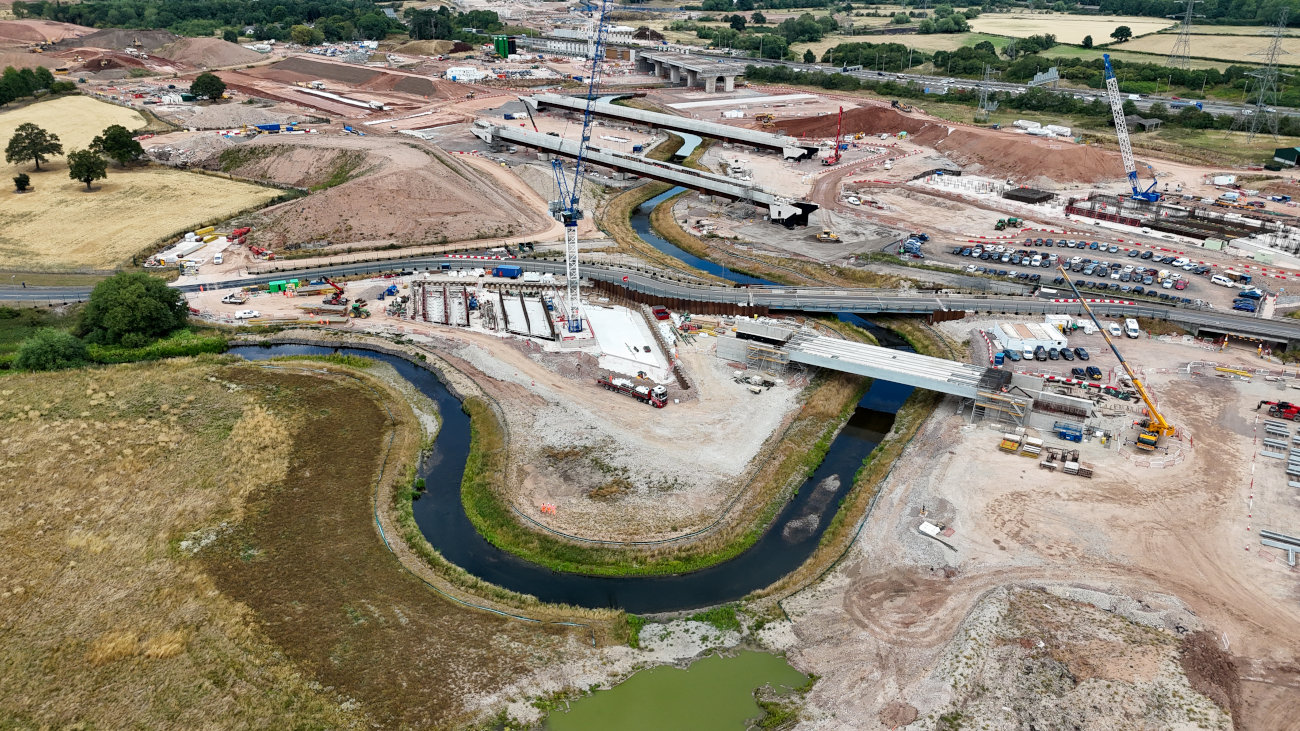HS2 successfully completes major river realignment project in Warwickshire
HS2 has completed a major river enhancement in Warwickshire, which at 749m is the most significant realignment of a natural river on the project.
The re-naturalisation of the River Cole near Coleshill in Warwickshire will improve the existing river environment by creating more meander bends and enhancing habitats in the river and along its banks to maximise biodiversity.
To build the Birmingham Spur of the Delta Junction, one of the most complex construction areas on the entire HS2 route, a section of the river needed to be permanently realigned to support the construction of two new viaducts and a series of railway embankments.

The realignment project was designed by HS2’s Mott MacDonald SYSTRA Design Joint Venture and delivered by ecologists and engineers working for HS2’s construction partner Balfour Beatty VINCI. In consultation with external stakeholders, including the Environment Agency, the team has created a holistic nature-based design.
Excavation works were completed in 2024 and temporary dams were then removed, allowing the water to flow into the new river section. Since then, the team has been monitoring how the new watercourse is establishing itself in flow, river shape and habitat characteristics.
In addition to environmental improvements, the design integrates recreational spaces and pathways alongside the river, drawing inspiration from the area's historical use as a boating lake by the Edwardians.
When the area is reopened to the public, communities will be able to enjoy new public spaces such as grassed embankments, footpaths, observation areas and Japanese style stepping stones over water features, which will enrich their experience of the natural environment around the river. This forms part of HS2’s Green Corridor along the route, creating a network of bigger, better-connected, climate resilient habitats and new green spaces for people and wildlife to enjoy in the future.
Simon Casey, HS2 Ltd’s head of environment for main works civils said:
“As climate change continues to pose challenges, HS2 aims to create solutions that successfully integrate climate resilient infrastructure, environmental preservation and positive community benefit.
“The holistic approach to this River Cole realignment is a shining example of this and it’s incredibly exciting to see what the team has achieved. It is part of our wider Green Corridor programme and will create a valuable learning legacy for the civil engineering profession, providing a replicable model for future projects.”
The design incorporates natural features that facilitate biodiversity. Riverbank planting, ponds, wet grasslands and pasture areas will support the rich abundance of species already present at the site, as well as encouraging a wider variety of species to thrive.
The natural river gravels within the floodplain have been retained and reused to form the riverbed, reducing carbon emissions, while also enhancing the natural river functioning and river habitat for aquatic species such as fish and invertebrates. In addition, biodegradable matting and coir pallets will help to establish native vegetation, control erosion and maintain the natural river flow.

The new meandering bends and asymmetrical cross-sections create opportunities for varied habitats to develop, as well as providing resilience during low and high flow conditions. The planting scheme also aids resilience to flood and climate change events, with strategic placement of vegetation playing a crucial role in regulating water flow.
Extensive hydraulic modelling was undertaken to ensure the watercourse realignment would not pose adverse flood risk to immediate or downstream areas. This has been achieved by reconfiguring the existing River Cole floodplain and creating new replacement flood storage areas and flood relief culverts.
Ian Johnson, project director at Mott MacDonald SYSTRA Design Joint Venture said:
“The River Cole realignment incorporates nature-based solutions, ecological enhancements, infrastructure resilience and environmental conservation which ensures the long-term sustainability of the local ecosystem.
“The multi-stage channel design with varied asymmetric cross-sections and increased meander bends creates a more natural river environment and more diverse habitat features, which enhances ecological resilience and promotes biodiversity in the area.
“The design not only improves flood resilience and natural river processes, it also contributes to the overall health of the river ecosystem, reduces carbon during construction, and creates public spaces for people to enjoy.”
A multi-disciplinary team has been involved in this complex project, including river engineers, geomorphologists, hydraulic modellers, engineers, agrotechnicians, landscape designers, architects and ecologists. With construction of the river realignment now complete, a HS2’s civils contractor in the West Midlands Balfour Beatty VINCI (BBV) will focus on completing the surrounding embankments and viaducts.
Michael Wood, ecology lead for the Delta Junction at Balfour Beatty VINCI Joint Venture said:
“As an ecologist, it’s exciting to be involved in a major landscape enhancement programme like this. It’s a unique opportunity to help shape this historic area of Warwickshire, which has previously been used as a medieval deer park and an expansive Elizabethan Garden, uncovered by HS2 archaeologists in 2021.
“We’re working collaboratively with our partners to build on this rich legacy and create a future where habitat connectivity and ecological features are enhanced, in-keeping with local characteristics.”
During the development of the design in this area, HS2 Ltd, Balfour Beatty VINCI, and the team at Mott MacDonald SYSTRA Design Joint Venture worked closely with the Environment Agency, local community, Independent Design Panel, Warwickshire County Council and North Warwickshire Borough Council.
The community have been particularly involved in ideas for high quality pathways for better connectivity, with the design aiming to revive the area's recreational aspect through the development of public green spaces and paths alongside the river.
The two River Cole viaducts, which span the river, are due to be completed later this year.


